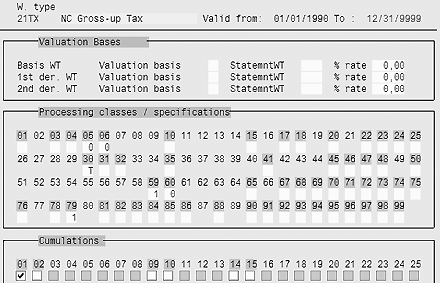In certain cases, such as for prizes and expatriate pay, a company wants to pay taxes for employees so that they take home the right amount in net pay. Using examples, the author explains the technicalities of the gross-up process, which starts with net pay and works backward to the gross amount.
Many companies use gross-ups for some payments to employees. Common examples are for prizes and expatriate pay. Suppose your company publicizes that any employee who has perfect attendance for a year will get a $100 bonus. That $100 is taxable income, which means the employee takes home only the after-tax portion of that. It doesn’t sound very good to say the bonus is $100 less any taxes you owe on it! To make sure the employee takes home $100 in cash, the company backs into the gross taxable amount, essentially paying the taxes on it on behalf of the employee.
Some companies also use gross-ups when paying expatriates because it makes the payment process easier. The company may determine that an expatriate needs $10,000 in net pay per month to meet all his or her requirements in the foreign country. So it pays the salary as a gross-up, ensuring the employee gets the right amount of money in net pay. Then the gross-up taxes are taken into account along with hypothetical taxes, home country, and host country taxes in the year-end tax equalization process.
With gross-ups, you start with net pay and work back up to the gross amount. Some numbers might make it easier to understand. Example 1, a simple gross-up, is shown in Figure 1. This employee received a $1,000 gross-up, meaning he received an extra $1,000 in net pay. Wage type 20NT was entered on infotype 0015 with an amount of $1,000. The payroll calculation backed into a gross taxable amount of $1,254.83, which was added to the employee’s taxable income. The tax on that $1,000 cash payment was $254.83.
| Table RT – Results Table |
(Collapsed |
Display) |
| ———————————————— ;—— |
|
| |A Wage type |
APC1 |
Amount |
| |
| ———————————————— ;—— |
|
| |* /101 Total gros |
|
3,254.83 |
| |
| |* /401 TX Withhol |
01 |
394.05 |
| |
| |* /401 TX Withhol |
03 |
120.02 |
| |
| |* /403 TX EE Soci |
01 |
201.80 |
| |
| |* /404 TX ER Soci |
01 |
201.80 |
| |
| |* /405 TX EE Medi |
01 |
47.20 |
| |
| |* /406 TX ER Medi |
01 |
47.20 |
| |
| |* /410 TX ER Unem |
01 |
26.04 |
| |
| |* /410 TX ER Unem |
02 |
87.88 |
| |
| |* /559 Payment |
|
2,491.76 |
| |
| |* /5U0 Tot EE tax |
|
763.07 |
| |
| |* /5U2 Tot gross- |
|
1,254.83 |
| |
| |* /701 RE Withhol |
01 |
3,254.83 |
| |
| |* /701 RE Withhol |
03 |
3,254.83 |
| |
| |* /703 RE EE Soci |
01 |
3,254.83 |
| |
| |* /704 RE ER Soci |
01 |
3,254.83 |
| |
| |* /705 RE EE Medi |
01 |
3,254.83 |
| |
| |* /706 RE ER Medi |
01 |
3,254.83 |
| |
| |* /710 RE ER Unem |
01 |
3,254.83 |
| |
| |* /710 RE ER Unem |
02 |
3,254.83 |
| |
| |3 20NT Gross-up N |
01 |
1,000.00 |
| |
| |* 20GR Gross-up G |
01 |
1,254.83 |
| |
| |3 0BAS Base Pay |
01 |
2,000.00 |
| |
|
|
| Figure 1 |
Example 1: A simple gross-up |
|
This employee also had $2,000 in base pay. That $2,000 and the $1,254.83 make up the total taxable income of $3,254.83 stored in the /7xx taxable income wage types. Unfortunately, the system does not store the amount of tax on the gross-up separately from the tax on the regular base pay. Instead they all are summed up into the /4xx tax wage types.
How Does It Work?
The configuration for gross-ups is not intuitive. The process starts with the net wage type 20NT shown in Figure 2. Although it carries the net amount, it does not cumulate to /101 and it is configured as a taxable wage type. Processing class 68 has a value of 5, which tells the system this is a gross-up. And as with other taxable wage types, processing class 71 is set to a value that reflects the taxability of the particular payment. The net wage type is linked to the gross wage type via the first statement wage type field.

Figure 2
Wage type 20NT configuration for the net part of a gross-up
The configuration of the gross wage type is almost opposite of the net part. Figure 3 shows the configuration of 20GR. The gross wage type does cumulate to /101 but is not taxable. Now that you know how the wage types are configured, you can see more clearly how the payroll calculation works. The gross-to-net calculation for the payroll result in example 1 is illustrated in Figure 4. Notice that the net wage type doesn’t have any part of the gross-to-net calculation. The only purpose it serves is as an input to the gross-up calculation.

Figure 3
Wage type 20GR configuration for the gross part of a gross-up
| Wage type |
Wage type text |
Amount
|
| ———————————————— ;—— |
| 20GR |
Gross-up |
1,254.83
|
| |
gross |
|
| 0BAS |
Base pay |
2,000.00
|
| ———————————————— ;—— |
| /101 |
Total gross |
3,254.83
|
| /401 |
TX Withhol |
394.05
|
| /401 |
TX Withhol |
120.02
|
| /403 |
TX EE Soci |
201.8
|
| /405 |
TX EE Medi |
47.2
|
| ———————————————— ;—— |
| /5U0 |
Tot EE tax |
763.07
|
| /559 |
Payment |
2,491.76
|
|
| Figure 4 |
Gross-to-net calculation |
|
There can also be no-pay gross-ups, which are used when you want to gross up an amount that is not payable to the employee. For example, an expatriate’s cost of living expenses might be paid via an expense report process in the host country. Since that payment is from an accounts payable system, it is not added to the employee’s wages, but it needs to be counted as taxable income. To make sure that it is included in the employee’s income, you process it through payroll as a no-pay wage adjustment. Instead of deducting the taxes on that amount from a future paycheck, you gross up the amount. There is no cash effect on the employee’s net pay in payroll. Only taxable wages and taxes are affected.
In this case, you have three wage types — one for the no-pay taxable gross amount, one for the no- pay net amount, and a nontaxable cash payment equal to the amount of taxes on that gross. Since taxes are always cash amounts, for no-pay gross-ups the system automatically generates a cash payment to cover the taxes, and there is no net payment effect on the employee. The configuration of no-pay gross-up wage types is a bit different than regular gross-ups. Figure 5 shows the difference in configuration of the no-pay net wage type 21NT – the addition of wage type 21TX in the second statement wage type field. Wage type 21TX is shown in Figure 6. It simply cumulates to cumulation class 01, which adds it to wage type /101 in the payroll calculation. The only difference in the gross wage type between 20GR and 21GR is that 21GR (not shown) does not cumulate to /101.

Figure 5
Wage type 21NT configuration for the net part of a no-pay gross-up

Figure 6
Configuring the tax payment part of a no-pay gross- up
Now I’ll give you example 2, the result of a $1,000 no-pay gross-up, which is shown in Figure 7. Of course, since the employee has regular taxable income, those taxes are also subtracted from the total. Wage type 21NT contains the $1,000 no-pay net, which results in a no-pay gross amount of $1,254.83 in wage type 21GR. Neither of those wage types cumulate to total gross, so neither results in a payment. However, the gross-up calculation adds $1,254.83 to taxable wages, and taxes are calculated on it. Wage type /701 is equal to wage types 0BAS plus 21GR.
| Table RT - Results Table |
(Collapsed |
Display) |
|
| ———————————————— ; |
|
| |A Wage type |
APC1 |
Amount |
| |
| ———————————————— ; |
|
| |* /101 Total gros |
|
2,254.83
|
| |
| |* /401 TX Withhol |
01 |
394.05
|
| |
| |* /401 TX Withhol |
03 |
120.02
|
| |
| |* /403 TX EE Soci |
01 |
201.80
|
| |
| |* /404 TX ER Soci |
01 |
201.80
|
| |
| |* /405 TX EE Medi |
01 |
47.19
|
| |
| |* /406 TX ER Medi |
01 |
47.19
|
| |
| |* /410 TX ER Unem |
01 |
13.96
|
| |
| |* /410 TX ER Unem |
02 |
87.88
|
| |
| |* /559 Payment |
|
1,491.77
|
| |
| |* /5U0 Tot EE tax |
|
763.06
|
| |
| |* /5U2 Tot gross- |
|
1,254.83
|
| |
| |* /701 RE Withhol |
01 |
3,254.83
|
| |
| |* /701 RE Withhol |
03 |
3,254.83
|
| |
| |* /703 RE EE Soci |
01 |
3,254.83
|
| |
| |* /704 RE ER Soci |
01 |
3,254.83
|
| |
| |* /705 RE EE Medi |
01 |
3,254.83
|
| |
| |* /706 RE ER Medi |
01 |
3,254.83
|
| |
| |* /710 RE ER Unem |
01 |
1,745.17
|
| |
| |* /710 RE ER Unem |
02 |
3,254.83
|
| |
| |3 21NT NC Gross-u |
01 |
1,000.00
|
| |
| |* 21GR NC Gross-u |
01 |
1,254.83
|
| |
| |* 21TX NC Gross-u |
01 |
254.83
|
| |
| |3 0BAS Base Pay |
01 |
2,000.00
|
| |
|
|
| Figure 7 |
Example 2: no-pay gross-up |
|
Wage type 21TX is automatically generated by the USTAX function. It is equal to the tax on the gross-up — $254.83. This is how the payroll calculation makes this a zero net effect on the employee’s net pay. It adds $254.83 to total gross in anticipation of taking that same amount in taxes.
Taxation of Gross-Ups
In SAP US Payroll, gross-ups are taxed when earned. This is opposite of regular payments, which are taxed when paid. There is no noticeable difference between the two methods until the employee has some retroactive payroll calculations or a claim that has to be cleared. If a regular wage, such as base pay, increases retroactively, then that incremental difference is brought to the current period for taxation. If the employee lived in Ohio when that base pay was originally earned, but now lives in Michigan when the retroactive difference is paid, that incremental amount will be taxed in Michigan.
If the increase had been in a gross-up, then the incremental difference would be calculated using Ohio taxes, since that is where it was first earned. The fact that the difference is paid when the employee is currently in Michigan doesn’t matter.
The taxed-when-earned method affects how users clear claims in payroll, particularly when there is a mix of gross-ups and regular wages that creates the claim. SAP’s best practice for clearing claims, available at SAP’s Service Marketplace at https://service.sap.com/hrusa, doesn’t really address claims on gross-ups. The claim created by a gross-up is an after-tax amount, while regular payments create claims that contain taxable money. To clear a claim created by a gross-up, simply enter a nontaxable payment wage type in the same amount as the claim. When the gross-up created the claim, it also reduced the employee’s taxable wages, so there is no infotype 0221 adjustment needed.
Retro Changes in Gross-Ups
Since gross-ups are taxed when earned, that means taxes can change retroactively. Suppose in the first example that the employee retroactively changed from a location with no local tax to Columbus, Ohio, which has a local tax. Since the employee now has a local tax, the gross-up recalculates the gross amount so that the Columbus local tax can be paid. When taxes on a gross-up increase, so does the gross amount. Figure 8 the next page shows example 3 — what happened to example 1 when I retroactively changed the employee’s tax location so that additional taxes were considered.
| ———————————————— ; |
| |A Wage type |
APC1 |
Amount
|
| |
| ———————————————— ; |
| |* /101 Total gros |
|
3,290.43
|
| |
| |* /401 TX Withhol |
01 |
394.05
|
| |
| |* /401 TX Withhol |
03 |
120.02
|
| |
| |* /403 TX EE Soci |
01 |
201.80
|
| |
| |* /404 TX ER Soci |
01 |
204.01
|
| |
| |* /405 TX EE Medi |
01 |
47.20
|
| |
| |* /406 TX ER Medi |
01 |
47.71
|
| |
| |* /410 TX ER Unem |
01 |
26.32
|
| |
| |* /410 TX ER Unem |
02 |
88.84
|
| |
| |* /551 Retrocalc. |
|
35.60-
|
| |
| |* /559 Payment |
|
2,491.76
|
| |
| |* /5U0 Tot EE tax |
|
763.07
|
| |
| |* /5U2 Tot gross- |
|
1,290.43
|
| |
| |* /701 RE Withhol |
01 |
3,290.43
|
| |
| |* /701 RE Withhol |
03 |
3,290.43
|
| |
| |* /701 RE Withhol |
04 |
3,290.43
|
| |
| |* /703 RE EE Soci |
01 |
3,290.43
|
| |
| |* /704 RE ER Soci |
01 |
3,290.43
|
| |
| |* /705 RE EE Medi |
01 |
3,290.43
|
| |
| |* /706 RE ER Medi |
01 |
3,290.43
|
| |
| |* /710 RE ER Unem |
01 |
3,290.43
|
|
| |* /710 RE ER Unem |
02 |
3,290.43
|
| |
| |* /N01 NTK Withho |
01 |
5.34
|
| |
| |* /N01 NTK Withho |
03 |
1.73
|
| |
| |* /N01 NTK Withho |
04 |
65.81
|
| |
| |* /N03 NTK: EE OA |
01 |
2.21
|
| |
| |* /N05 NTK: EE Me |
01 |
0.51
|
| |
| |3 20NT Gross-up N |
01 |
1,000.00
|
| |
| |* 20GR Gross-up G |
01 |
1,290.43
|
| |
| |3 0BAS Base Pay |
01 |
2,000.00
|
| |
|
|
| Figure 8 |
Example 3: a retroactive change on a gross- up |
|
The payroll tax schema UTX0 has a function UTPRI that is designed to process the priority of tax withholdings and to control the handling of retroactive changes in taxes. By default, it is delivered with parameter 1 empty, which often breaks the gross-up process. (Each payroll function has four parameters that can be filled via schema maintenance transaction PE01.) If the tax amount changes retroactively, function UTPRI limits the amount of tax that is taken retroactively to the amount of tax taken in the original period. For example 3, it limits the total tax in the retro calculation to $763.07 even though the gross- up calculation calculated higher taxes. The difference between the taxes that R/3 wanted to use for the recalculated result and what the taxes were limited to is placed in uncollected tax wage types /Nxx. Even though the taxes are limited, the gross-up result is not. The difference between the original gross-up ($1,254.83) and the new gross-up result ($1,290.43) is paid out as a retro difference in wage type /551 ($35.60). The total uncollected taxes are greater than $35.60 because of the increased tax on the base pay.
Function UTPRI can be changed by adding a value of U to parameter 1. In this case, when taxes retroactively change, it will take as much as was in the original payroll’s /101 wage type instead of looking at /5U0. This is a much better option, since the increase in gross-up taxes is fully taken and accounted for in the retro period and uncollected taxes are eliminated.
Retros into Prior Tax Years
Another side effect of gross-ups being taxed when earned occurs when a gross-up changes in a prior tax year. You can use the example of the employee who retroactively changes his tax location to Columbus, all the way back into a prior tax year. When the gross- up recalculates, it comes up with a higher tax. If function UTPRI is set up with parameter 1 equal to a U, then the increased taxes won’t be limited. However, function UOTX0 gets in the way. It is designed to prevent taxes in prior years from changing, so even though UTPRI lets the increase go through, UOTX0 limits the taxes to their original values. There is no option to control this behavior other than using infotype 0221 adjustments to manipulate tax amounts.
When the gross-up amount increases in the prior year, but the taxes remain the same, the difference is paid to the employee, just as happened in example 3. Since 20GR increases but total taxes do not, the system recognizes a difference in the gross to net and places it in wage type /551 as a retroactive difference. If the gross value had decreased, then that money would have been taken from the employee’s current paycheck.
If you do have to retroactively calculate an employee into a prior tax year and that ends up changing gross-ups, you can use a work-around. Simulate the employee’s payroll to see how much money is being limited by UOTX0, and, in this case, let’s assume that amount is $100. Offset that retro amount with a post- tax deduction on the employee’s current check, wage type 0DED for $100. This achieves a zero-net effect on his current period paycheck. Then create an infotype 0221 payroll adjustment dated in the prior year, using the wage type 0DED and the taxes that should have received that money, as shown in Figure 9. This infotype 0221 adjustment simply moves money from the deduction wage type into various tax wage types.

Figure 9
Create payroll adjustment for refund of gross- up
Steve Bogner
Steve Bogner is a managing partner at Insight Consulting Partners and has been working with SAP HR since 1993. He has consulted for various public, private, domestic, and global companies on their SAP HR/Payroll implementations; presented at the SAP user's group ASUG; and been featured on the Sky Radio Network program regarding SAP HR.
Steve will be presenting at the upcoming HR Payroll Seminar November 7-8 in Chicago and November 27-28 in Orlando. For information on the event, click
here.
You may contact the author at sbogner@insightcp.com.
If you have comments about this article or publication, or would like to submit an article idea, please contact the editor.












